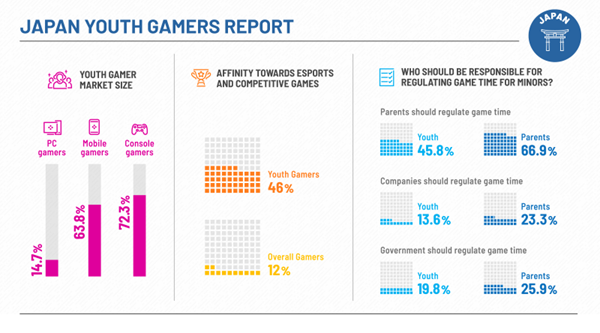Most Youth Gamers Play on Console (72%) Followed by Mobile (64%) and then PC (15%)
What You Will Learn from This Report:
This comprehensive report examines Japanese youth gamers and their parents’ opinions toward video games. It reveals how Japanese youth behavior differs from that of older gamers in several realms such as esports, game discovery, and game choices. Additionally, it explores device preferences, gaming time, game live streaming, opinions on game regulations, and game addiction issues - a primary concern among Japanese parents. Our report covers gamers who are 6-18 years old and play games for at least 1 hour per week.
The Japan Youth Gamers report offers actionable insights and recommendations to help you tailor your strategies and effectively target this key market segment, ensuring you maximize your share of the current and future market opportunities.
Key Takeaways:
- Most youth gamers play on console (72%) followed by mobile (64%) and then PC (15%). Parents favor consoles due to increased visibility and control over gaming content compared to other platforms.
- Youth gamers play an average of 8 hours per week on mobile, compared to 6.5 hours on PC and console.
- Japanese youth are more receptive than adult gamers to foreign game titles, esports, game live streaming, and VTubers. Nearly 46% of Japanese youth are drawn into esports and competitive games, compared to 12% of overall Japanese gamers.
- Premium games still play a large role in Japan, primarily due to the popularity of consoles, and are the most popular individual purchase made by youth gamers.
- Parents of Japanese youth are generally accepting of video games as a means of entertainment and are more likely to be gamers themselves.
- The majority of both parents and youth in general believe that control over children's game time should be managed by each family, rather than by the government or game companies, with 66.9% of parents and 45.8% of youth agreeing with this.
Table of Contents
1. Preface
Companies Mentioned
- Bandai Namco
- Computer Entertainment Supplier’s Association (CESA)
- Dentsu
- Disney
- DreamHack
- Gakken Institute of Education
- Japan esports Union (JeSU)
- Japan Online Game Association (JOGA)
- Konami
- Ministry of Education, Culture, Sports, Science and Technology (MEXT)
- Mobile Content Forum (MCF)
- NASEF
- National Institute for Educational Policy Research
- Nifty
- Nintendo
- NTT
- Riot Games
- Sega
- Sony
- Sony Music Entertainment
- Statistics Japan









